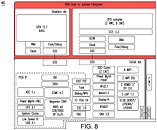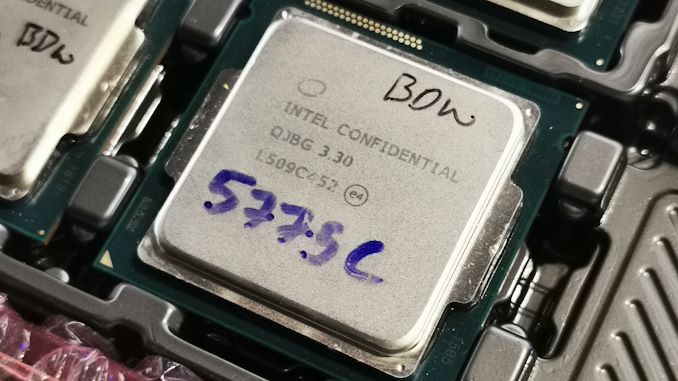- Joined
- Oct 9, 2007
- Messages
- 46,511 (7.66/day)
- Location
- Hyderabad, India
| System Name | RBMK-1000 |
|---|---|
| Processor | AMD Ryzen 7 5700G |
| Motherboard | ASUS ROG Strix B450-E Gaming |
| Cooling | DeepCool Gammax L240 V2 |
| Memory | 2x 8GB G.Skill Sniper X |
| Video Card(s) | Palit GeForce RTX 2080 SUPER GameRock |
| Storage | Western Digital Black NVMe 512GB |
| Display(s) | BenQ 1440p 60 Hz 27-inch |
| Case | Corsair Carbide 100R |
| Audio Device(s) | ASUS SupremeFX S1220A |
| Power Supply | Cooler Master MWE Gold 650W |
| Mouse | ASUS ROG Strix Impact |
| Keyboard | Gamdias Hermes E2 |
| Software | Windows 11 Pro |
We've known from a recent report that "Meteor Lake" introduces an L4 cache, and now we are learning that it is codenamed "Adamantine," and serves functions resembling that of a passive interposer. Intel's upcoming "Meteor Lake" microarchitecture will power the company's first disaggregated processor for the client segment.
A disaggregated processor is different from an MCM (such as "Clarkdale"), since finer components that make up the processor that otherwise can't exist on their own packages without extreme latency, are made to share a single package via a high-speed interconnect. This disaggregation is purely for economic reasons, so the company needn't use the latest (and most expensive) foundry node for the entire processor, but ration it to the specific components that benefit the most from it. Unlike AMD client processors that disaggregate the CPU cores and the remaining processor I/O into two kinds of chiplets, Intel "Meteor Lake" will see the breaking up of not just CPU cores (compute tile), but also the iGPU on its own tile, besides the platform I/O on separate tiles still.

Until now, it was believed that Intel's Foveros packaging innovation, which removes the need for an expensive silicon interposer, would facilitate communications among the various tiles, but now we're learning that the processor will in fact feature an L4 cache memory that provides passive interposer capabilities. By itself, a silicon interposer has no logic. It's only function is to serve as a base for the various logic and memory tiles to be seated on top, so it could provide high-density microscopic wiring among them, which would otherwise not be possible through fiberglass package substrate. An L4 cache is something else, and "Meteor Lake" features an L4 cache acting as a base-tile, and acting like a passive interposer (a misnomer if you understand how it works). This tile has been codenamed "Adamantine."
"Adamantine" is a base tile with a level-4 (L4) cache memory. The physical media is unknown (whether it is expensive SRAM or eDRAM), and the size would vary among the variants of "Meteor Lake," but what this essentially does is interconnect the various tiles via cache memory. While an "active" interposer is a dumb piece of silicon with high-density wiring as we explained earlier, a "passive" interposer is a memory with connections to the various tiles.
For a tile to communicate with another, data with the right tags is retired to this L4 cache, which is then picked up by its addressee tile. This is essentially the same way the shared L3 caches on Intel processors work, and which is how the CPU cores, iGPU, and uncore components talk to each other. Scale up this concept at a disaggregated processor level, and you understand how the L4 cache works. The individual tiles have their own "last level caches" (LLCs) at their local level. The Compute Tile, for example, has an L3 cache shared among the P-cores and E-core clusters. This is the L3 cache that's exposed to the OS.
To be clear, "Meteor Lake" still has direct die-to-die data connections among the various tiles, but these connections do not follow a radial topology (where each tile is directly connected to every other tile). It's only the SoC tile that appears to have die-to-die connections with the Compute Tile (CPU cores), Graphics Tile (iGPU), I/O tile, and PMC. In scenarios where, for example, the Compute Tile would want to communicate with the Graphics Tile, the L4 cache would serve as a lower latency path, than through the SoC tile.
The size of the L4 cache is really not known, but if it is based on a slower physical media than the SRAM that makes up the L3 cache in the Compute Tile, it stands to reason that it will be considerably larger in size. "Moore's Law is Dead" reports that L4 cache sizes in the range of 128 MB to 512 MB are being tested, although they could even run into gigabytes, the tech channel notes.
View at TechPowerUp Main Site | Source
A disaggregated processor is different from an MCM (such as "Clarkdale"), since finer components that make up the processor that otherwise can't exist on their own packages without extreme latency, are made to share a single package via a high-speed interconnect. This disaggregation is purely for economic reasons, so the company needn't use the latest (and most expensive) foundry node for the entire processor, but ration it to the specific components that benefit the most from it. Unlike AMD client processors that disaggregate the CPU cores and the remaining processor I/O into two kinds of chiplets, Intel "Meteor Lake" will see the breaking up of not just CPU cores (compute tile), but also the iGPU on its own tile, besides the platform I/O on separate tiles still.

Until now, it was believed that Intel's Foveros packaging innovation, which removes the need for an expensive silicon interposer, would facilitate communications among the various tiles, but now we're learning that the processor will in fact feature an L4 cache memory that provides passive interposer capabilities. By itself, a silicon interposer has no logic. It's only function is to serve as a base for the various logic and memory tiles to be seated on top, so it could provide high-density microscopic wiring among them, which would otherwise not be possible through fiberglass package substrate. An L4 cache is something else, and "Meteor Lake" features an L4 cache acting as a base-tile, and acting like a passive interposer (a misnomer if you understand how it works). This tile has been codenamed "Adamantine."
"Adamantine" is a base tile with a level-4 (L4) cache memory. The physical media is unknown (whether it is expensive SRAM or eDRAM), and the size would vary among the variants of "Meteor Lake," but what this essentially does is interconnect the various tiles via cache memory. While an "active" interposer is a dumb piece of silicon with high-density wiring as we explained earlier, a "passive" interposer is a memory with connections to the various tiles.
For a tile to communicate with another, data with the right tags is retired to this L4 cache, which is then picked up by its addressee tile. This is essentially the same way the shared L3 caches on Intel processors work, and which is how the CPU cores, iGPU, and uncore components talk to each other. Scale up this concept at a disaggregated processor level, and you understand how the L4 cache works. The individual tiles have their own "last level caches" (LLCs) at their local level. The Compute Tile, for example, has an L3 cache shared among the P-cores and E-core clusters. This is the L3 cache that's exposed to the OS.
To be clear, "Meteor Lake" still has direct die-to-die data connections among the various tiles, but these connections do not follow a radial topology (where each tile is directly connected to every other tile). It's only the SoC tile that appears to have die-to-die connections with the Compute Tile (CPU cores), Graphics Tile (iGPU), I/O tile, and PMC. In scenarios where, for example, the Compute Tile would want to communicate with the Graphics Tile, the L4 cache would serve as a lower latency path, than through the SoC tile.
The size of the L4 cache is really not known, but if it is based on a slower physical media than the SRAM that makes up the L3 cache in the Compute Tile, it stands to reason that it will be considerably larger in size. "Moore's Law is Dead" reports that L4 cache sizes in the range of 128 MB to 512 MB are being tested, although they could even run into gigabytes, the tech channel notes.
View at TechPowerUp Main Site | Source





